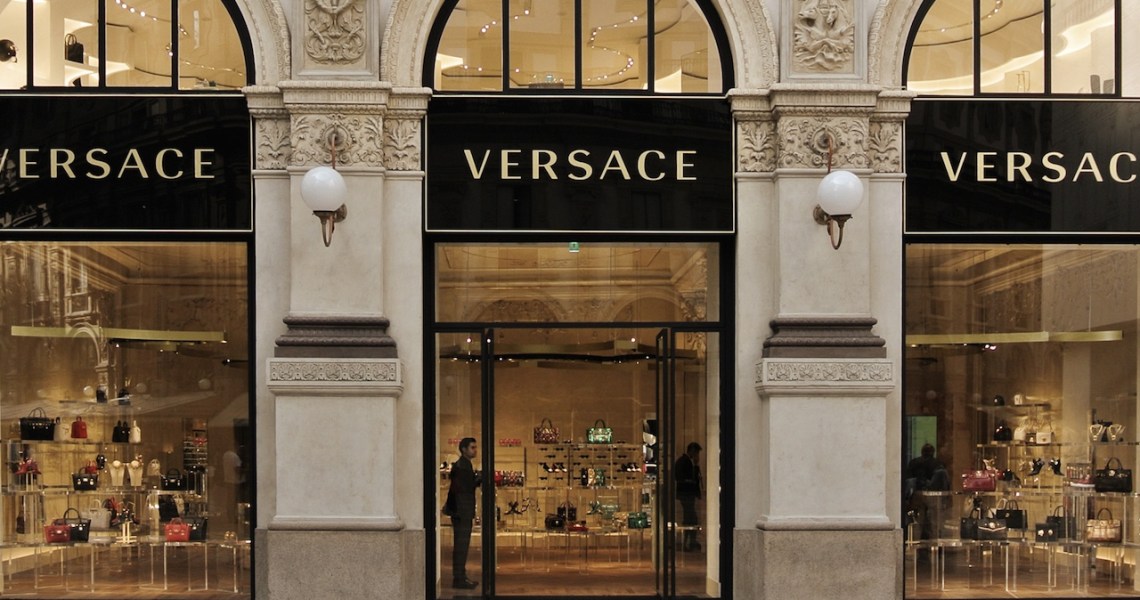To stay up-to-date on the latest runway shows, digital presentations and behind-the-scenes buzz, sign up to receive Glossy’s daily NYFW Briefing (February 11-16).
Despite the boom in e-commerce across 2021, the prevailing sentiment among luxury brands and retailers this year has been a sense of optimism around brick-and-mortar retail.
In earnings calls and statements throughout January and the beginning of February, luxury brands including Versace, Thom Browne and Gucci have all made plans to open bigger and more numerous stores, betting on a return to in-store shopping to pay back that investment. With luxury spending fully recovering in 2021, past pre-pandemic levels, big conglomerate-backed brands now have the confidence and the cash flow needed to resume their store-opening plans.
On a February 2 earnings call, Capri Holdings CEO John Idol signaled the company’s intention to keep its store fleet strong. Versace has 212 stores, Jimmy Choo has 240 and Michael Kors has 834. Versace was the only one of those three brands to end 2021 with fewer stores than it began the year with, but now Idol said the plan is to open more than 100 new Versace stores in the next year.
“We saw traffic in our stores accelerate during the quarter, which — that’s not something we’ve seen in a long time,” Idol said during the call. “And that really speaks to the health of the consumer across the globe.”
Not only will Capri be opening new stores, but over the next two years, around 50% of all the company’s 1,000-plus existing stores will be renovated or expanded.
Thom Browne CEO Rodrigo Bazan made similar statements in January, as reported by Footwear News. After its parent company Ermenegildo Zegna went public in January, the brand plans to build on its 80 global stores by more than 100 by 2023.
Ad position: web_incontent_pos1
The main focus of Thom Browne’s retail growth will be in China, but more stores in the U.S. and Europe are coming, as well.
Gucci, meanwhile, has also been opening stores, including a flagship in Detroit and a massive store in embattled New Jersey mall American Dream, both in January. And Ralph Lauren plans to open 90 new stores this year.
The effects of these expansion intentions can also be seen outside the luxury industry. For example, Simon Property Group is expecting an increase in leases to luxury retail brands in the upcoming year. On the company’s earnings call early this week, David Simon, CEO of Simon Property Group, said there are a number of reasons to be optimistic about more retail stores opening this year. The company is relying on new store openings to drive its revenue in 2022.
But notably, the confidence in brick-and-mortar — including the return of foot traffic — is limited to luxury. Foot traffic for retail mass apparel retailers including JCPenney was down by as much as 10% in December and January, while luxury retail foot traffic remained strong.
“Most [mass] consumers are not keen on engaging in-person right now, but rather, are more comfortable shopping online,” said Andrew Hunter, co-founder of job search platform Adzuna.
Ad position: web_incontent_pos2
Much of the upcoming retail growth will be focused on luxury brands associated with conglomerates, like Capri, Zegna and LVMH. But even smaller luxury brands are taking an interest in opening new stores.
“We’ve been using pop-ups as testing opportunities,” said designer Jonathan Simkhai, who opened a pop-up in Dallas in January. “We’ve seen a tremendous response so far, so we’re interested in opening more permanent stores because of that initial reaction.”
According to Idol, even the biggest brands have lots of room to grow physical retail in 2022.
“We could grow revenues by 4x in our stores and still not be at the productivity levels of some of our biggest competitors in the world,” Idol said.




